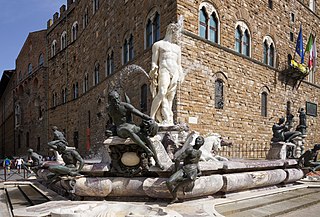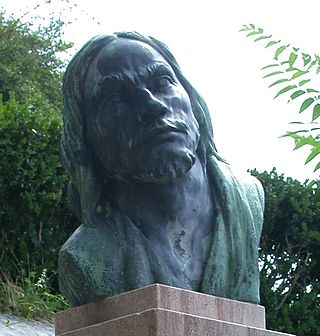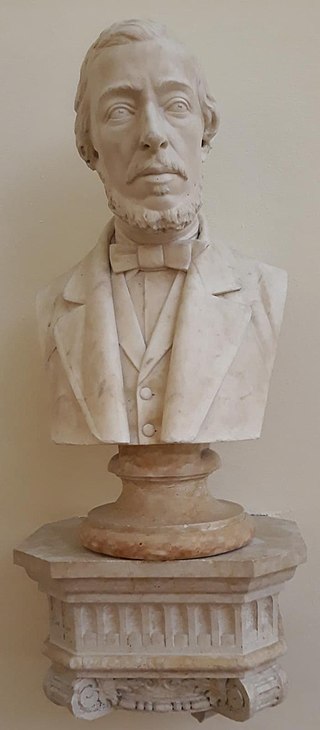
Bartolomeo Ammannati was an Italian architect and sculptor, born at Settignano, near Florence, Italy. He studied under Baccio Bandinelli and Jacopo Sansovino and closely imitated the style of Michelangelo.

BartolomeoMontagna was an Italian Renaissance painter who mainly worked in Vicenza. He also produced works in Venice, Verona, and Padua. He is most famous for his many Madonnas and his works are known for their soft figures and depiction of eccentric marble architecture. He is considered to be heavily influenced by Giovanni Bellini, in whose workshop he might have worked around 1470. Benedetto Montagna, a productive engraver, was his son and pupil and active until about 1540. He was mentioned in Vasari's Lives as a student of Andrea Mantegna but this is widely contested by art historians.

Tsai Ming-liang is a Malaysian filmmaker based in Taiwan. Tsai has written and directed 11 feature films, many short films, and television films. He is one of the most celebrated "Second New Wave" film directors of Taiwanese cinema. His films have been acclaimed worldwide and have won numerous awards at festivals. In 1994, Tsai won the Golden Lion at the 51st Venice International Film Festival for the film Vive L'Amour.

The Gallerie dell'Accademia is a museum gallery of pre-19th-century art in Venice, northern Italy. It is housed in the Scuola della Carità on the south bank of the Grand Canal, within the sestiere of Dorsoduro. It was originally the gallery of the Accademia di Belle Arti di Venezia, the art academy of Venice, from which it became independent in 1879, and for which the Ponte dell'Accademia and the Accademia boat landing station for the vaporetto water bus are named. The two institutions remained in the same building until 2004, when the art school moved to the Ospedale degli Incurabili.

Bernardo Strozzi, named il Cappuccino and il Prete Genovese, was an Italian Baroque painter and engraver. A canvas and fresco artist, his wide subject range included history, allegorical, genre and portrait paintings as well as still lifes. Born and initially mainly active in Genoa, he worked in Venice in the latter part of his career. His work exercised considerable influence on artistic developments in both cities. He is considered a principal founder of the Venetian Baroque style. His powerful art stands out by its rich and glowing colour and broad, energetic brushstrokes.

Bartolomeo d'Alviano was an Italian condottiero and captain who distinguished himself in the defence of the Venetian Republic against the Holy Roman Emperor Maximilian.

Pordenone, Il Pordenone in Italian, is the byname of Giovanni Antonio de’ Sacchis, an Italian Mannerist painter, loosely of the Venetian school. Vasari, his main biographer, wrongly identifies him as Giovanni Antonio Licinio. He painted in several cities in northern Italy "with speed, vigor, and deliberate coarseness of expression and execution—intended to shock".
Domenico Montagnana was an Italian master luthier based in Venice, Italy. He is regarded as one of the finest violin and cello makers of his time.

Bartolomeo Gradenigo was the 53rd Doge of Venice from 7 November 1339 until his death.

Andrea Antico was a music printer, editor, publisher and composer of the Renaissance born in the Republic of Venice, of Istrian birth, active in Rome and in Venice. He was the first printer of sacred music in Rome, and the earliest competitor of Venetian Ottaviano Petrucci, who is regarded as the first significant music printer.

Bartolomeo Nazari was an Italian painter of the late-Baroque, mainly active in Venice as a portraitist.
The first decade of the 16th century marked the creation of some significant compositions. These were to become some of the most famous compositions of the century.
Icelandic art has been built on northern European traditions of the nineteenth century, but developed in distinct directions in the twentieth century, influenced in particular by the unique Icelandic landscape as well as by Icelandic mythology and culture.

Abramo Bartolommeo Massalongo was an Italian paleobotanist and lichenologist. He was born in Tregnago in the Province of Verona and took a great interest in botany as a young man. Massalongo joined the faculty of medicine at the University of Padua in 1844. Along with Gustav Wilhelm Körber, he founded the "Italian-Silesian" school of lichenology. He also collaborated with Martino Anzi. He was the husband of Maria Colognato and the father of hepaticologist Caro Benigno Massalongo. He also worked in the scientific field of herpetology. Massalongo edited the exsiccata Lichenes Italici Exsiccati (1855-1856). In 1859 his Catalogo dei rettili delle province venete was published in Venice.

Antonio Zona was an Italian painter, active in a style fusing Neoclassicism and Romantic style.

Cosroe Dusi was an Italian painter in the Neoclassical style, active for many years in St Petersburg, Russia, painting mainly sacred and historical subjects. Dusi was nicknamed by his contemporaries the "modern Tintoretto", for his liveliness of invention and rapidity at painting.

Giuseppe Valiani was an Italian painter.

Bartolomeo della Nave was a Venetian merchant and art collector.
Antonio Bruti was an Albanian trader, agent, merchant and diplomat, part of the Bruti family, who worked for Venice in the cities of Ulqin and Ragusa working with Venetian-Ottoman relations.















